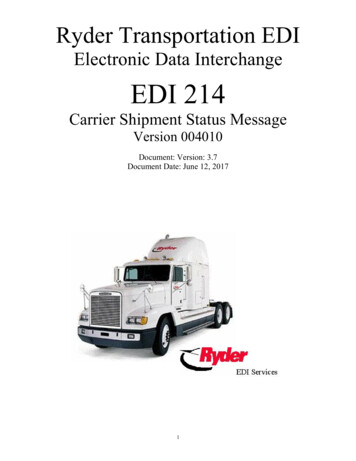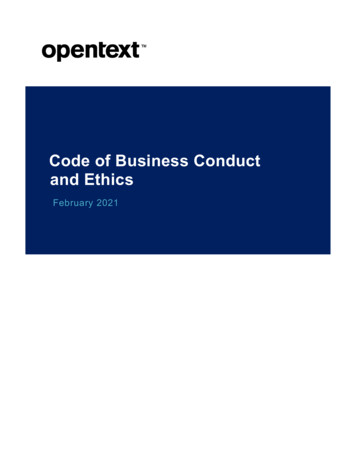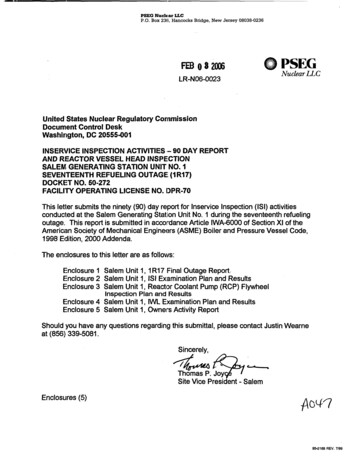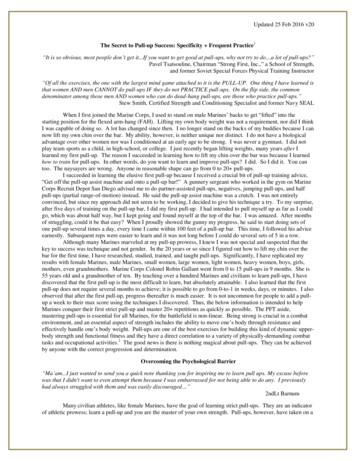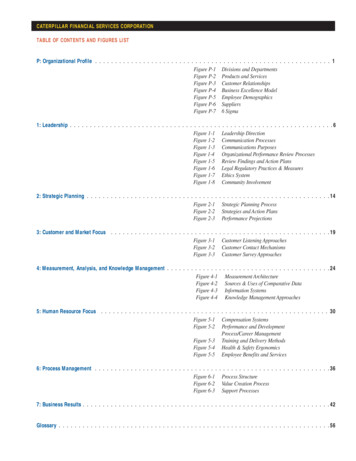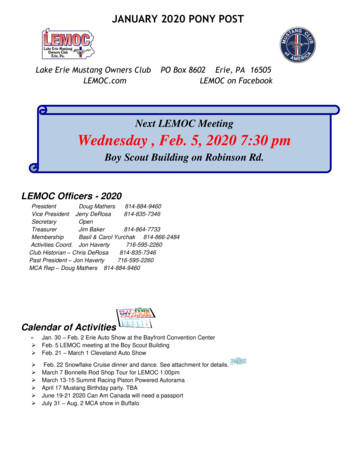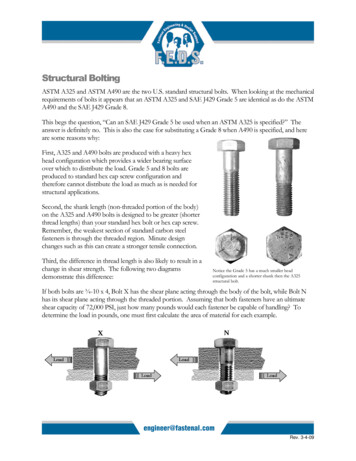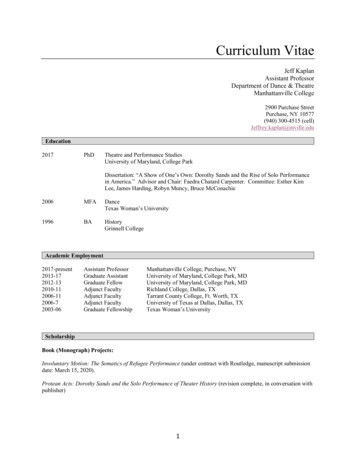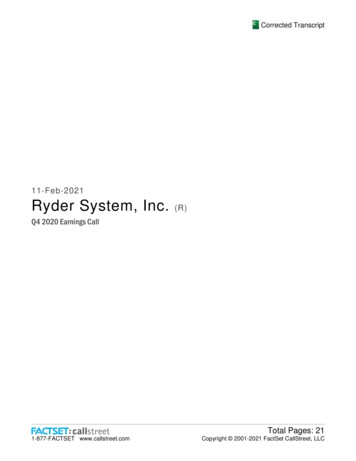
Transcription
Corrected Transcript11-Feb-2021Ryder System, Inc.(R)Q4 2020 Earnings CallTotal Pages: 211-877-FACTSET www.callstreet.comCopyright 2001-2021 FactSet CallStreet, LLC
Ryder System, Inc. (R)Corrected TranscriptQ4 2020 Earnings Call11-Feb-2021CORPORATE PARTICIPANTSRobert S. BrunnJ. Steven SensingVice President-Investor Relations, Corporate Strategy & New ProductStrategy, Ryder System, Inc.President-Global Supply Chain Solutions, Ryder System, Inc.Robert E. SanchezPresident-Fleet Management Solutions, Ryder System, Inc.Chairman & Chief Executive Officer, Ryder System, Inc.John J. DiezScott T. ParkerChief Financial Officer & Executive Vice President, Ryder System, Inc.OTHER PARTICIPANTSStephanie BenjaminJordan AlligerAnalyst, Truist Securities, Inc.Analyst, Goldman Sachs & Co. LLCScott H. GroupJustin LongAnalyst, Wolfe Research LLCAnalyst, Stephens, Inc.Todd FowlerBrian P. OssenbeckAnalyst, KeyBanc Capital Markets, Inc.Analyst, JPMorgan Securities LLCAllison Poliniak-CusicDavid G. RossAnalyst, Wells Fargo Securities LLCAnalyst, Stifel, Nicolaus & Co., Inc.21-877-FACTSET www.callstreet.comCopyright 2001-2021 FactSet CallStreet, LLC
Ryder System, Inc. (R)Corrected TranscriptQ4 2020 Earnings Call11-Feb-2021MANAGEMENT DISCUSSION SECTIONOperator: Good morning and welcome to the Ryder System's Fourth Quarter 2020 Earnings ReleaseConference Call. All lines are in a listen-only mode until after the presentation. Today's call is being recorded. Ifyou have any objections, please disconnect at this time.I would now like to introduce Mr. Bob Brunn, Senior Vice President, Investor Relations, Corporate Strategy andNew Product Strategy for Ryder. Mr. Brunn, you may begin.Robert S. BrunnVice President-Investor Relations, Corporate Strategy & New Product Strategy, Ryder System, Inc.Thanks very much. Good morning and welcome to Ryder's fourth quarter 2020 earnings conference call. I'd like toremind you that during this presentation, you'll hear some forward-looking statements within the meaning of thePrivate Securities Litigation Reform Act of 1995. These statements are based on management's currentexpectations and are subject to uncertainty and changes in circumstances. Actual results may differ materiallyfrom these expectations due to changes in economic, business, competitive, market, political, and regulatoryfactors. More detailed information about these factors and a reconciliation of each non-GAAP financial measure tothe nearest GAAP measure is contained in this morning's earnings release, earnings call presentation, and inRyder's filings with the Securities and Exchange Commission, which are available on Ryder's website.Presenting on today's call are Robert Sanchez, Chairman and Chief Executive Officer; and Scott Parker,Executive Vice President and Chief Financial Officer. Additionally, John Diez, President of Global FleetManagement Solutions; and Steve Sensing, President of Global Supply Chain Solutions and DedicatedTransportation, are on the call today and available for questions following the presentation.At this time, I'll turn the call over to Robert.Robert E. SanchezChairman & Chief Executive Officer, Ryder System, Inc.Good morning, everyone, and thanks for joining us. On our call this morning, we'll provide an overview of 2020and review our fourth quarter results. We'll then discuss our outlook for 2021 and review the progress we'remaking on actions to achieve our ROE target. Following our prepared remarks, we'll open the call for questions.With that, let's turn to an overview of 2020. We're encouraged to see economic and freight conditions continue toimprove, which is benefiting all areas of our business. Market awareness of the importance of supply chainreliability has increased as a result of the pandemic. We believe that accelerating trends in the areas such as ecommerce fulfillment, last mile delivery, big and bulky goods, and on-shoring and near-shoring will continue tosupport growth opportunities, especially in our supply chain and dedicated businesses.We made important progress on our actions to achieve target returns and expect that to continue in 2021. Despitethe numerous challenges faced in 2020, we remain focused on investing in innovative customer solutions andbranding that support our long-term strategic objectives.In the second quarter, we launched RyderShare, our freight visibility and collaboration platform, and areencouraged by the traction we've already seen with nearly 2 million shipments tracked to-date with supply chain31-877-FACTSET www.callstreet.comCopyright 2001-2021 FactSet CallStreet, LLC
Ryder System, Inc. (R)Q4 2020 Earnings CallCorrected Transcript11-Feb-2021and dedicated customers. In the third quarter, we launched a brand awareness campaign, communicating Ryder'sbroad range of logistics capabilities, which has resulted in an increase in sales leads and website activity. We alsolaunched RyderVentures, our corporate venture capital fund, focused on investing in disruptive technologies thatis intended to help bring new and innovative products to our customers.Full year 2020 earnings were negatively impacted by the depreciation from prior residual value estimate changesin COVID-19. These headwinds were partially offset by higher lease results and lower maintenance costs. Thedepreciation impact is expected to decline going forward and vehicle residual value estimates are set at or nearhistoric lows. Supply chain automotive activity was impacted by COVID-19, but has recovered. Rental and usedvehicle sales were also impacted and continue to improve.During 2020, we generated record free cash flow of 1.6 billion due to lower capital spending, and our leveragewas reduced to within our target range as of year-end. While 2020 presented unprecedented challenges, I amextremely proud of the many ways in which the Ryder team supported our customers and our communities safelyand efficiently. Although we still have work ahead of us, I'm confident that Ryder is well positioned for 2021.At this point, I'll turn over to Scott to discuss fourth quarter results and key trends that we saw in each of ourbusiness segments.Scott T. ParkerChief Financial Officer & Executive Vice President, Ryder System, Inc.Thanks, Robert. Total company results for the fourth quarter on page 5, operating revenue of 1.8 billion in thefourth quarter was in line with the prior year, as higher revenue in supply chain was offset by lower revenues infleet management and dedicated. Comparable earnings per share from continuing operations was 0.83 pershare in the fourth quarter as compared to a loss of 0.01 in the prior year.Higher earnings reflect improved used vehicle sales results and a declining depreciation expense impact relatedto prior residual value estimate changes. Improved lease and rental results also contributed to higher earnings.Adjusted ROE for the trailing 12-month period reflects lower earnings mainly due to depreciation expense relatedto prior residual value estimate changes and COVID impacts. Record free cash flow in 2020 reflects lower capitalspending and improved working capital management.Turning to FMS results on page 6. Fleet management solutions operating revenue decreased by 3%, primarilydue to lower rental revenue partially offset by higher lease revenue. Rental revenue declined 7%, reflecting lowerdemand, partially offset by a 6% increase in pricing. ChoiceLease revenue increased 1%, primarily due to 4%higher pricing on leased vehicles, partially offset by the impact of a lower active fleet due reduced sales andrenewal activity.FMS realized pre-tax earnings of 60 million, which includes 86 million of depreciation expense impact related tothe prior residual value estimate changes, net of realized gains on the sale of used vehicles. This impact is lowerthan the prior year, resulting in a year-over-year earnings benefit of 62 million. Including this benefit, total FMSpre-tax earnings improved by 141 million.Results also benefited from higher lease performance, reflecting lower insurance costs from the discontinuance ofour lease liability insurance extension program and higher pricing. Rental results benefited from lowermaintenance costs, including benefits from our cost savings initiative and earlier actions taken to align the fleetwith lower demand due to COVID and higher pricing.41-877-FACTSET www.callstreet.comCopyright 2001-2021 FactSet CallStreet, LLC
Ryder System, Inc. (R)Corrected TranscriptQ4 2020 Earnings Call11-Feb-2021Utilization on the power fleet was 79% in the fourth quarter, above the prior year of 76%, on a 16% smaller fleet.Utilization improved throughout the quarter as we saw incremental demand. FMS EBT as a percent of operatingrevenue for the fourth quarter was 5%. For full year 2020, it was negative 3.1%, below the company's long-termtarget of high-single digits, primarily reflecting depreciation expense from prior residual value estimate changes.Page 7 highlights global used vehicle sales results for the quarter. We're encouraged by the continuedimprovement in the used vehicle market conditions with double-digit price increases for both tractors and trucks.Globally, year-over-year proceeds were up 15% for tractors and 22% for trucks. Sequentially, tractor proceedswere up 13% and truck proceeds were up 16% versus the third quarter. Higher sales proceeds primarily reflectimproved market pricing and, to a lesser extent, a higher mix of vehicles sold through our retail channels.On the second quarter call, we provided the sensitivity noting that a 10% price increase for trucks and a 30%price increase for tractors in the US is needed by 2022 in order to maintain our current policy depreciationresidual estimates. Since the second quarter, US truck proceeds were up 20% and tractor proceeds were up24%. Although these increases are not age or mix adjusted, they are generally indicative of pricing improvementsthat have occurred since the second quarter of 2020.As such, based on these improvements, current truck residual values have exceeded levels that would not requireadditional policy residual value adjustments and our current tractor values are approaching those levels. Duringthe quarter, we sold 7,000 used vehicles, up 17% from the prior year, reflecting improved market conditions andinvestments that expanded our retail sales capacity. Used vehicle inventories held for sale was 7,700 vehicles atquarter end and is squarely within our target range of 7,000 to 9,000 vehicles. Inventory was down 1,700 vehiclesfrom the prior year and down 3,000 vehicles sequentially.Turning to supply chain on page 8, operating revenue versus the prior year increased 8%, primarily due to newbusiness, higher pricing and increased volumes. Growth was driven by the consumer packaged goods, retail andautomotive sectors. SCS pre-tax earnings increased 5% reflecting higher pricing and new business, partiallyoffset by favorable insurance claims development in the prior year and higher compensation-related costs. SCSEBT as a percent of operating revenue was 6.8% for the quarter. It was 8.6% for the full year, in line with ourlong-term target of high-single digits.Moving to dedicated on page 9, operating revenue versus the prior year was down 4%, reflecting the impact oflower contractual sales in late 2019 and early 2020. DTS earnings before tax decreased 16% due to favorableprior-year insurance claims development, partially offset by improved higher operating performance. DTS EBT asa percent of operating revenue was 6.6% for the quarter. It was 7.9% for the full year, in line with our high-singledigit target.I'll turn the call back over to Robert to discuss our outlook for 2021.Robert E. SanchezChairman & Chief Executive Officer, Ryder System, Inc.Thank, Scott. As a reminder, page 10 highlights our primary long-term financial target of 15% ROE over the cycle.The segment operating revenue growth and pre-tax earnings goals we previously outlined and that are shownhere are key components to achieving this target. As we mentioned before, reaching our adjusted ROE of 11% tomatch our cost of equity is just an interim target.51-877-FACTSET www.callstreet.comCopyright 2001-2021 FactSet CallStreet, LLC
Ryder System, Inc. (R)Corrected TranscriptQ4 2020 Earnings Call11-Feb-2021On page 11, we've outlined some key assumptions for our 2021 outlook. As visibility has improved from last year,we thought it was an appropriate time to reinstate financial guidance, albeit with somewhat wider ranges than inthe past, due to lingering uncertainty regarding COVID and the overall economy. Our 2021 forecast is based onour assumption of a moderate macroeconomic growth environment for the year.For the full year, we're expecting mid-single-digit operating revenue growth for the total company. SCS and DTSare expected to grow by high-single digits, in line with their long-term targets. FMS operating revenue growth isexpected to be near the lower end of its mid-single-digit target due to lower lease sales. We expect the full yeartax rate to be in its normal range of the high-20s assuming the current tax policy.In FMS, the depreciation impact from prior residual value estimate changes is expected to continue to decline,resulting in year-over-year earnings benefit of approximately 220 million for the full year of 2021, 50 million inthe first quarter of 2021 and 100 million in the full year of 2022. These benefits do not include any potentialimpact from gains or losses on sale or valuation adjustments. Rental revenue, used vehicle sales results andlease sales activity are expected to be higher in 2021.In SCS, we expect higher contractual sales activity and pre-tax earnings as a percent of operating revenue toremain in the high-single-digit target range, driven by improved operating performance, partially offset byincreased strategic investments.DTS contractual sales activity is also expected to be higher than the prior year, however pre-tax earnings as apercent of operating revenue is expected to be slightly below the high-single-digit target range as increasedstrategic investments offset the benefits of growth.Turning to page 12, as we laid out in late 2019, we continue to execute on our capital allocation strategy toachieve our long-term ROE target of 15% and generate positive free cash flow over the cycle. We're focused onaccelerating growth in our higher ROE supply chain and dedicated businesses with moderate growth in ourcapital-intensive FMS business.We remain committed to our dividend, subject to board approval, and plan to continue to reduce leverage toimprove balance sheet flexibility for strategic opportunities and/or future share buybacks. We also plan to continueto invest in capabilities that will provide long-term revenue and earnings growth opportunities for Ryder, andleverage disruptive technologies in our industry. These capabilities may develop organically, through acquisitionsor via strategic partnerships and investments.I'll turn the call back over to Scott to discuss capital spending and cash flow.Scott T. ParkerChief Financial Officer & Executive Vice President, Ryder System, Inc.Thanks, Robert. Turning to slide 13, full year gross capital expenditures shown in the chart at the bottom of thepage are expected to be between 2 billion to 2.3 billion in 2021, up from 1.1 billion last year. This increasereflects higher investments in the lease and rental fleets, following the year in 2020, where spending was wellbelow normalized replacement levels, primarily due to COVID.In 2021, lease capital expenditures are expected to be between 1.4 billion and 1.6 billion, up from around 850million in 2020. Lease sales activity is forecasted to improve as a better economic environment resulting inincreased capital spending. However, a modest decline in lease fleet is still expected due to low sales activity in61-877-FACTSET www.callstreet.comCopyright 2001-2021 FactSet CallStreet, LLC
Ryder System, Inc. (R)Corrected TranscriptQ4 2020 Earnings Call11-Feb-2021late 2020 and early 2021. Forecasted lease spending this year is in line with the normalized replacementspending of about 1.3 billion to 1.4 billion, as shown by the dotted line on the chart.Rental capital expenditures are expected to be between 500 million and 600 million, up significantly from 85million last year. Approximately 250 million will be used to grow the rental fleet by approximately 10% in order tocapture increased demand expected from strong e-commerce and freight market activity. The remaininginvestment will be used to refresh the fleet. As shown on the chart, forecasted rental CapEx spending in 2021 isabove the normalized level of rental replacement of 450 million, following a well below replacement spendinglast year.Turning to slide 14, 2021 free cash flow is expected at 400 million to 700 million and reflects our strategy tobalance growth in the capital-intensive FMS business with generating free cash flow over the cycle. 2021forecasted free cash flow is below the record level of last year under COVID conditions, but is well abovehistorical levels.Balance sheet leverage this year is expected to remain within our target. Importantly, we expect to approach ourinterim ROE target of 11% this year, driven primarily by the declining depreciation impact from prior residual valueestimate changes. Rental demand recovery and initiatives, including maintenance cost savings, are also expectedto contribute to higher returns. Comparable EBITDA increased in 2020, reflecting contractual growth andimproved operating performance. We expect comparable EBITDA to continue to increase in 2021.I'll turn the call back over to Robert to discuss our strategic initiatives.Robert E. SanchezChairman & Chief Executive Officer, Ryder System, Inc.Slide 15 highlights some of the key strategic initiatives and investments in technology that we expect will enhancethe customer experience and provide long-term revenue and earnings growth. We're continuing to expand thecapabilities of our visibility and collaborative logistics platform, RyderShare. Launched in the second quarter oflast year, RyderShare offers deeper capabilities in our competitive solutions and is translating t
Ryder System, Inc. (R ) Q4 2020 Earnings Call Corrected Transcript 11 -Feb -2021 . Results also benefited from higher lease performance, reflecting lower insurance costs from the discontinuance of our lease liability insurance extension progra
